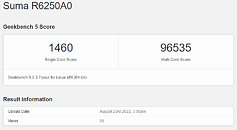The next-generation flagship AMD GENOA EPYC CPU has recently appeared on Geekbench 5 in a dual-socket configuration for a total of 192 cores and 384 threads. The processors were installed in an unknown Suma 65GA24 motherboard running at 3.51 GHz and paired with 768 GB of DDR5 memory. This setup achieved a single-core score of 1460 and multi-core result of 96535 which places the processor approximately 17% ahead of an equivalently clocked 128 core EPYC 7763 in single-threaded performance. The Geekbench listing also includes an OPN code of 100-000000997-01 which most likely corresponds to the flagship AMD EPYC 9664 with a max TDP of 400 W according to existing leaks.


View at TechPowerUp Main Site | Source


View at TechPowerUp Main Site | Source








 ), so it's far from basing anything on a single benchmark, but rather their own claims that are seeming more and more like reality with every passing week.
), so it's far from basing anything on a single benchmark, but rather their own claims that are seeming more and more like reality with every passing week. (8000 series might actually be, but that will be more akin to 2000 over 1000, i.e. a polished turd
(8000 series might actually be, but that will be more akin to 2000 over 1000, i.e. a polished turd